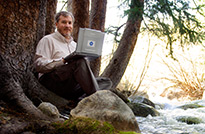UWyo Magazine
January 2014 | Vol. 15 No. 2
UW Professor Fred Ogden works to determine long-term sustainability of water in the Colorado River Basin.
By Ron Podell
 Water: It’s one of those daily necessities we often take for granted. Water is vital
to everything we do, from that morning shower to the food on our dinner plate and
everything in between. For many states, having enough water now and in the future
is a constant worry.
Water: It’s one of those daily necessities we often take for granted. Water is vital
to everything we do, from that morning shower to the food on our dinner plate and
everything in between. For many states, having enough water now and in the future
is a constant worry.
One of Wyoming’s largest water sources—the Colorado River Basin—is shared with six other states. Water levels in the Colorado River Basin are dependent upon a number of factors, including winter snowmelt and how much communities near and far use this crucial water source. To determine how long and how much the basin can support, Fred Ogden and his colleagues are working to create a computational model of the hydrology of the upper Colorado River Basin—roughly 112,000 square miles that run from Wyoming and Colorado down to Lake Powell. The Green River, the biggest tributary of the Colorado River, is the first area that will be modeled, Ogden says.
“Our ultimate goal is to understand long-term sustainability of water in the Colorado River Basin,” explains Ogden, the Cline Distinguished Chair in the University of Wyoming’s Department of Civil and Architectural Engineering, and Haub School of Environment and Natural Resources.
“We have our computer code running and are working to parallelize it,” he says. Parallel computing is a form of computation in which many calculations are carried out simultaneously. Working with the U.S. Army Corps of Engineers and the National Center for Atmospheric Research (NCAR), Ogden expects the parallelized code to be up and running by March 2014.
During the past year, Ogden has built his research staff—a research and modeling specialist, a postdoctoral student and several graduate students—to assist with model development. He works collaboratively with Craig Douglas, School of Energy Resources professor of mathematics, and Kristi Hansen, assistant professor in Agricultural and Applied Economics, to simulate the hydrology and use of water in the Colorado River Basin. Through computer simulations, they want to determine how much water is available in the basin, including Lake Powell, a man-made reservoir that straddles the borders between Arizona and Utah.
The lake, under the Colorado River Compact, stores water for the Upper Basin states of Wyoming, Colorado, Utah and New Mexico to meet demands under the 1922 compact.
Under the compact’s rules, Upper Basin states have to provide a minimum of 75 million acre-feet of water every 10 years to the Lower Basin states of Arizona, California and Nevada. One acre-foot of water is defined as one acre of water 1 foot deep, which translates to roughly enough water for a family of four for one year, Ogden says.
Determining just how much water is available will allow municipalities to make educated decisions about the long-term sustainability of water for their communities based on such factors as climate change, irrigation needs, natural and man-made land use changes, and population shifts, Ogden says.
This study is important because there is uncertainty about how Wyoming, in the next several decades, will meet its own water needs while still meeting obligations to the Lower Basin states.
Ogden spearheads UW’s efforts with the CI-Water project, which is funded with an Experimental Program to Stimulate Competitive Research Infrastructure Improvement Program Track-2 cooperative agreement. The $6 million grant provides $2.4 million to UW. The other $3.6 million went to Brigham Young University, the University of Utah and Utah State University.
To assist UW’s efforts, Ogden purchased $1 million worth of computer nodes (138 in all) on Mount Moran, UW’s Advanced Research Computing Center.
“We are using Mount Moran for code development and smaller scale runs, and data analysis,” Ogden says. “Once our model is scaled up to larger watersheds, we will do most of our simulations on Yellowstone (the supercomputer at the NCAR-Wyoming Supercomputing Center).”
Approximately 70 percent of all freshwater used worldwide goes to agriculture. Because the western U.S. is more arid than the rest of the nation, per capita water use for agriculture is much higher, making water a key resource. The research Ogden and his team have underway can help Wyoming plan for the future in order to best meet the water needs of residents, farmers and ranchers alike.
UWYO MAGAZINE
The Magazine for Alumni and Friends of the University of Wyoming
Contact Us
UWyo Magazine
University of Wyoming
Dept. 3226
1000 East University Ave.
Laramie, WY 82071-2000
Phone: 307-766-2379
TTY: 307-766-6729
Email: uwyomag@uwyo.edu
University of Wyoming
Dept. 3226
1000 East University Ave.
Laramie, WY 82071-2000
Phone: 307-766-2379
TTY: 307-766-6729
Email: uwyomag@uwyo.edu
